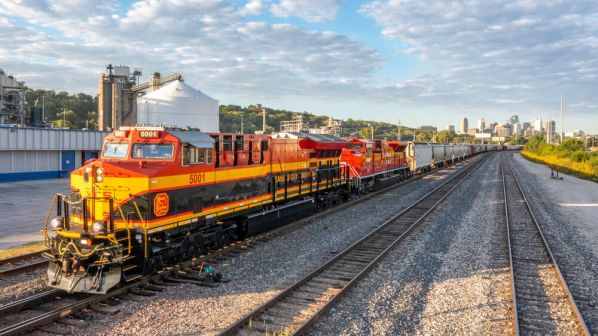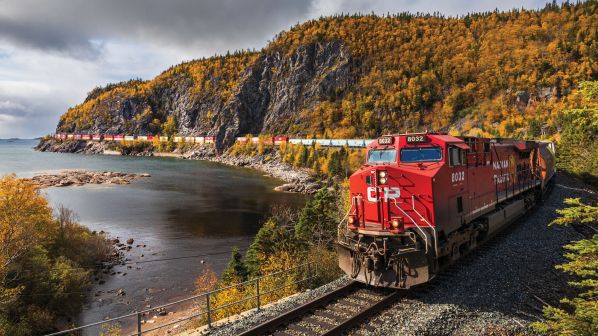APRIL 14 marked a pivotal moment in North American Class 1 history. The driving of a ceremonial last spike in Kansas City, Missouri, marked the merger of Canadian Pacific (CP) and Kansas City Southern (KCS) into Canadian Pacific Kansas City (CPKC), the first single-line, transnational railway connecting Canada, the United States and Mexico.
It was also a milestone in the process to combine the full operational and organisational capabilities of the two companies to realise the efficiencies and improvements touted by the railways as the reasons why the merger was required. Discussions had already been underway between staff at various levels for many months before the newly combined company operated its first service in April.
Playing a major role within this integration is Mr John Orr, executive vice-president and chief transformation officer of CPKC. Orr has been given responsibility for network operations planning and design, procurement, labour relations and regulatory affairs. He previously served as executive vice-president operations at KCS, overseeing the Transportation, Engineering, Mechanical, Network Operations, Health-Safety-Environmental and Labour Relations functions.
“To be the person granted the responsibility to bring the two cultures of these wonderful organisations together to optimise competitive capability and the infrastructure and the resources that we have is a terrific challenge, and one that’s going to take a little bit of experience, and a little bit of navigation,” Orr said during the Rail Insights online conference hosted by IRJ’s sister publication Railway Age on June 22.
Orr worked with his CP counterpart, Mr Mark Redd, now executive vice-president and chief operating officer at CPKC, to develop the structure of the operating plan. The lack of physical overlap between the two railways simplified the process, he says, but the process has also focused on utilising the existing strengths of the two companies.
“It’s putting railway experience to work where, under two separate entities you don’t have the capital commitment or the service commitments to do upstream activities in order to make the downstream first-mile/last-mile service orientation as optimised as possible,” he says.
Much of this work has focused on optimising the use of freight terminals, such as by minimising the number of handlings by using the hump yard in Minneapolis/St Paul, Minnesota, to undertake handling that might otherwise have taken place in Shreveport, Louisiana, or even as far away as Monterrey in Mexico.
“It was really how we minimise the number of handlings, how we create capacity by bypassing yards or doing block swaps that avoid a lot of pin-pulling and switching and handling in an area in order to speed up the overall network,” Orr says. “And it’s working. We’ve been able to realise even more gains relative to terminal performance, how wagons are handled in the service yards, and how they’re getting to and from our customers a lot more effectively.”
This process is ever evolving with responses from depot managers and customers feeding back to the service design team. “Our operating team is helping us evolve and adapt even quicker than we thought,” Orr says.
“To be the person granted the responsibility to bring the two cultures of these wonderful organisations together to optimise competitive capability and the infrastructure and the resources that we have is a terrific challenge.”
John Orr, CPKC executive vice-president and chief transformation officer
As well as operations, the merger also necessitated the consolidation of the two railways’ IT systems.
“In a lot of places, CP had a better legacy system, while in some places KCS had a more refined legacy system,” Orr says. “In the integration process, we looked at the best cases for each place, and took the technology or the operation technology platforms, and made them from whichever legacy system was superior.”
This work is expected to take three to five years to complete, and Orr says the IT and operational technology (OT) teams so far have had to deal with every kind of failure possible. “In a rapid response they’ve been able to fix things, to the extent that our customers and our end users have hardly even felt that,” Orr says. “It’s like the operating plan, with a lot of experience and a lot of hard work behind the scenes planning and… getting the structure ready, and then being able to deal with those exceptions very robustly.”
Cross-border intermodal
CP and KCS were already collaborating before the merger on an interline basis to launch a dedicated cross-border intermodal service between Lázaro Cárdenas in Mexico and CP’s Bensenville Yard in Chicago in March 2022.
This proved the power of using alternative ports such as Lázaro Cárdenas, Orr says, and acted as the precursor to the launch of CPKC’s Mexico Midwest Express (MMX) in May. MMX-180 now operates from Chicago to San Luis Potosí, with MMX-181 operating from San Luis Potosí to Chicago. The trains offer a three-day service between Chicago and Laredo, four-day service to and from Monterrey, and four and a half-day service to and from San Luis Potosí. The total transit time from Chicago to San Luis Potosí is 98 hours, a day faster than the nearest competitor.
“MXV-180 and 181 have been running 100% on-time departure [and] 100% on-time arrival since their inception,” Orr says. “And that’s really the first proof point of the single-line service capability associated with the merger.”

Orr says this operational efficiency has become a point of pride for the staff involved. “It tells you that the operating discipline that you associate with CP has translated well across both the former KCS properties in the US and in Mexico, and the people who are making it happen are engaged, energised and committed,” he says. “And so our Lázaro Cárdenas train, converting over to 180 and 181, is really proving a rallying cry for everyone.”
The efficiency of single-line operation has also allowed CPKC to increase the number of refrigerated wagons it hauls.
“As you can appreciate, perishable goods don’t take dwell very well, and so we move them with great discipline,” Orr says. “The fact that we can now move products in both directions in those reefers, proteins from the central United States into Mexico, and then fresh fruit back into the marketplaces in parts of Canada and the US that need them, helps tremendously.
“It’s exciting to see that, and we take that same approach with auto parts… and other parts of the supply chain that are vital to some of the economic strategies of Mexico, the US and Canada, and are really underpinned in the United States-Mexico-Canada Agreement (USMCA), which helped facilitate the structure and discipline around the trade of these products for these three great countries.”
A major choke point are the border crossings, especially between the United States and Mexico. However, work has begun on a second international rail bridge spanning the Rio Grande River from Laredo, Texas, to Nuevo Laredo in the Mexican state of Tamaulipas.
The new single-track bridge, to be completed by the end of 2024, will be constructed alongside the existing bridge, while new customs facilities, including for clearance and pre-clearance, are also being built and existing facilities upgraded.
CP and KCS were aligned on this investment from the start, Orr says. “Those investments were really targeting service capability through the border complexes, really concentrated between Shreveport, Houston, and Monterrey,” he says. “So that was a great proof point that we were two great minds thinking alike.”
Major investment has also gone into the Rosenberg and Laredo freight depots. CPKC has laid 14.4km of additional track on the approach to the Laredo depot, and a third track on the line from Laredo towards the border to optimise the use of the new bridge.
“I get the privilege of being the person at the company that gets to articulate how we’re achieving those measures, how we’re complying with what we said we would do.”
John Orr
“It’s a win-win for everybody who uses that border, and that would include Union Pacific (UP) as well as the CPKC trains,” he says.
CPKC is also working with the US Customs and Border Protection (CBP) agency and Mexico’s Tax Administration Service (SAT) on measures to accelerate the customs clearance process, such as using the same data points to assess goods coming across the border. The railway is similarly working with the US Federal Railroad Administration (FRA) and the Mexican government on customs pre-clearance for freight consignments.
“That truly is one of the franchise differentiators that we’re focused on and have been for quite some time,” Orr says.
As CPKC executive vice-president and chief transformation officer, the majority of Orr’s responsibility lies in pulling together the two companies’ cultural capabilities and creating a competitive landscape for the railway’s operating and non-operating teams.
He is also responsible for reporting progress to the Surface Transportation Board (STB), which set a number of requirements when approving the merger.
“[The chairman of the STB, Mr] Marty Oberman gave us a great opportunity and showed a lot of faith in us in the combination, but they also had some aggressive oversight parameters,” Orr says. “I get the privilege of being the person at the company that gets to articulate how we’re achieving those measures, how we’re complying with what we said we would do and working across both legacy companies to make sure that we’ve got that alignment from our obligations there and our STB metrics.”
On top of this, Orr is responsible for recruiting and retaining staff and “making sure that what we do is lining up to the values and the visions of CPKC.”
“The regulatory environment in all three countries is going to get more and more complex, but therein lie a lot of opportunities to improve on the physical infrastructure by having a complementary public doctrine that lines up to facilitate trade in a responsible, secure way,” he says.
Ultimately, Orr says, it comes down to understanding whether the company is doing what it told the STB and customers it would do, and then capitalising on that knowledge to further improve services.
Putting the right people in the right places was also important when merging the two companies, and Orr says that this resulted in a meritocracy of sorts, with staff from both companies appointed to roles in CPKC based on their skills and experience.
He points to a number of positions within the company that have been filled by moving staff from other areas within the railway. “We’re taking talent and moving them… into key positions, whether they’re from one legacy company or another,” he says. “You work hard, you produce results, you add value, and that merit will get you more and more responsibility.”
John Orr was speaking to Railway Age editor, William Vantuono, at the publication's Rail Insights Conference in June.

